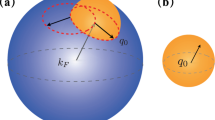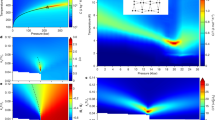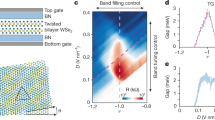Abstract
A many-body quantum system on the verge of instability between two competing ground states may exhibit quantum-critical phenomena1,2, as has been intensively studied for magnetic systems. The Mott metal–insulator transition3, a phenomenon that is central to many investigations of strongly correlated electrons, is also supposed to be quantum critical, although this has so far not been demonstrated experimentally. Here, we report experimental evidence for the quantum-critical nature of the Mott instability, obtained by investigating the electron transport of three organic systems with different ground states under continuously controlled pressure. The resistivity obeys the material-independent quantum-critical scaling relation bifurcating into a Fermi liquid or Mott insulator, irrespective of the ground states. Electrons on the verge of becoming delocalized behave like a strange quantum-critical fluid before becoming a Fermi liquid.
This is a preview of subscription content, access via your institution
Access options
Subscribe to this journal
Receive 12 print issues and online access
$259.00 per year
only $21.58 per issue
Buy this article
- Purchase on SpringerLink
- Instant access to full article PDF
Prices may be subject to local taxes which are calculated during checkout

 (δP, T) of κ-Cu2(CN)3 measured from the metal–insulator crossover line against δP = P − Pc(T).
(δP, T) of κ-Cu2(CN)3 measured from the metal–insulator crossover line against δP = P − Pc(T).


Similar content being viewed by others
References
Sachdev, S. Quantum Phase Transitions (Cambridge Univ. Press, 2011).
Sondhi, S. L., Girvin, S. M., Carini, J. P. & Shahar, D. Continuous quantum phase transitions. Rev. Mod. Phys. 69, 315–333 (1997).
Mott, N. F. Metal–Insulator Transitions (Taylor & Francis, 1990).
Terletska, H., Vučičević, J., Tanasković, D. & Dobrosavljević, V. Quantum critical transport near the Mott transition. Phys. Rev. Lett. 107, 026401 (2011).
Senthil, T. Theory of a continuous Mott transition in two dimensions. Phys. Rev. B 78, 045109 (2008).
Misawa, T. & Imada, M. Quantum criticality around metal–insulator transitions of strongly correlated electron systems. Phys. Rev. B 75, 115121 (2007).
McWhan, D., Menth, A., Remeika, J., Brinkman, W. & Rice, T. Metal–insulator transitions in pure and doped V2O3 . Phys. Rev. B 7, 1920–1931 (1973).
Yao, X., Honig, J., Hogan, T., Kannewurf, C. & Spałek, J. Electrical properties of NiS2−xSex single crystals: From Mott insulator to paramagnetic metal. Phys. Rev. B 54, 17469–17475 (1996).
Lefebvre, S. et al. Mott transition, antiferromagnetism, and unconventional superconductivity in layered organic superconductors. Phys. Rev. Lett. 85, 5420–5423 (2000).
Limelette, P. et al. Mott transition and transport crossovers in the organic compound κ-(BEDT-TTF)2Cu[N(CN)2]Cl. Phys. Rev. Lett. 91, 016401 (2003).
Kagawa, F., Miyagawa, K. & Kanoda, K. Unconventional critical behaviour in a quasi-two-dimensional organic conductor. Nature 436, 534–537 (2005).
Georges, A., Kotliar, G., Krauth, W. & Rozenberg, M. J. Dynamical mean-field theory of strongly correlated fermion systems and the limit of infinite dimensions. Rev. Mod. Phys. 68, 13–125 (1996).
Vučičević, J., Terletska, H., Tanasković, D. & Dobrosavljević, V. Finite-temperature crossover and the quantum Widom line near the Mott transition. Phys. Rev. B 88, 075143 (2013).
Shimizu, Y., Miyagawa, K., Kanoda, K., Maesato, M. & Saito, G. Spin liquid state in an organic Mott insulator with a triangular lattice. Phys. Rev. Lett. 91, 107001 (2003).
Itou, T., Oyamada, A., Maegawa, S., Tamura, M. & Kato, R. Quantum spin liquid in the spin-1/2 triangular antiferromagnet EtMe3Sb[Pd(dmit)2]2 . Phys. Rev. B 77, 104413 (2008).
Kanoda, K. & Kato, R. Mott physics in organic conductors with triangular lattices. Annu. Rev. Condens. Matter Phys. 2, 167–188 (2011).
Kato, R. Development of π-electron systems based on [M(dmit)2] (M = Ni and Pd; dmit: 1,3-dithiole-2-thione-4,5-dithiolate) anion radicals. Bull. Chem. Soc. Jpn 87, 355–374 (2014).
Powell, B. J. & McKenzie, R. H. Quantum frustration in organic Mott insulators: From spin liquids to unconventional superconductors. Rep. Prog. Phys. 74, 056501 (2011).
Komatsu, T., Matsukawa, N., Inoue, T. & Saito, G. Realization of superconductivity at ambient pressure by band-filling control in κ-(BEDT-TTF)2Cu2(CN)3 . J. Phys. Soc. Jpn 65, 1340–1354 (1996).
Kurosaki, Y., Shimizu, Y., Miyagawa, K., Kanoda, K. & Saito, G. Mott transition from a spin liquid to a Fermi liquid in the spin-frustrated organic conductor κ-(ET)2Cu2(CN)3 . Phys. Rev. Lett. 95, 177001 (2005).
Kato, R., Tajima, A., Nakao, A., Tajima, N. & Tamura, M. in Multifunctional Conducting Molecular Materials (eds Saito, G. et al.) 32–38 (Royal Society of Chemistry, 2007).
Kobashi, K. Transport Properties Near the Mott Transition in the Quasi-Two-Dimensional Organic Conductor κ-(ET) 2 X Thesis, Univ. Tokyo (2007)
Simonian, D., Kravchenko, S. V. & Sarachik, M. P. Reflection symmetry at a B = 0 metal–insulator transition in two dimensions. Phys. Rev. B 55, R13421–R13423 (1997).
Amaricci, A. et al. Extended Hubbard model: Charge ordering and Wigner–Mott transition. Phys. Rev. B 82, 155102 (2010).
Witczak-Krempa, W., Ghaemi, P., Senthil, T. & Kim, Y. B. Universal transport near a quantum critical Mott transition in two dimensions. Phys. Rev. B 86, 245102 (2012).
Kravchenko, S. et al. Scaling of an anomalous metal–insulator transition in a two-dimensional system in silicon at B = 0. Phys. Rev. B 51, 7038–7045 (1995).
Kosterlitz, J. M. The critical properties of the two-dimensional xy model. J. Phys. C 7, 1046–1060 (1974).
Si, Q., Rabello, S., Ingersent, K. & Smith, J. L. Locally critical quantum phase transitions in strongly correlated metals. Nature 413, 804–808 (2001).
Senthil, T., Sachdev, S. & Vojta, M. Quantum phase transitions out of the heavy Fermi liquid. Physica B 359–361, 9–16 (2005).
Sachdev, S. Holographic metals and the fractionalized Fermi liquid. Phys. Rev. Lett. 105, 151602 (2010).
Davison, R. A., Schalm, K. & Zaanen, J. Holographic duality and the resistivity of strange metals. Phys. Rev. B 89, 245116 (2014).
Kato, R. & Hengbo, C. Cation dependence of crystal structure and band parameters in a series of molecular conductors, β′-(Cation)[Pd(dmit)2]2 (dmit = 1,3-dithiole-2-thione-4,5-dithiolate). Crystals 2, 861–874 (2012).
Acknowledgements
We would like to thank V. Dobrosavljević, N. Nagaosa, H. Oike and T. Itou for fruitful discussions. This work was supported in part by JSPS KAKENHI under Grant Nos 20110002, 25220709 and 24654101, and the US National Science Foundation under Grant No. PHYS-1066293 and the hospitality of the Aspen Center for Physics.
Author information
Authors and Affiliations
Contributions
T.F. and K.K. designed the experiments. T.F. performed the experiments and analysed the data. T.F. and K.K. interpreted the data. K.M., H.T. and R.K. grew the single crystals for the study. T.F. wrote the manuscript with the assistance of K.M. and K.K. K.K. headed this project.
Corresponding authors
Ethics declarations
Competing interests
The authors declare no competing financial interests.
Supplementary information
Supplementary Information
Supplementary Information (PDF 1097 kb)
Rights and permissions
About this article
Cite this article
Furukawa, T., Miyagawa, K., Taniguchi, H. et al. Quantum criticality of Mott transition in organic materials. Nature Phys 11, 221–224 (2015). https://doi.org/10.1038/nphys3235
Received:
Accepted:
Published:
Issue date:
DOI: https://doi.org/10.1038/nphys3235
This article is cited by
-
Quantum scaling for the metal–insulator transition in a two-dimensional electron system
Scientific Reports (2024)
-
Chasing the spin gap through the phase diagram of a frustrated Mott insulator
Nature Communications (2023)
-
Continuous Mott transition in semiconductor moiré superlattices
Nature (2021)
-
Low-temperature dielectric anomaly arising from electronic phase separation at the Mott insulator-metal transition
npj Quantum Materials (2021)
-
A quantum magnetic analogue to the critical point of water
Nature (2021)



